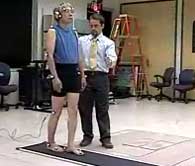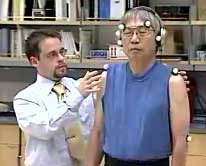Oregon Health and Sciences University researchers are testing a small device you can wear like a music player to help people with balance disorders stay upright.
To maintain balance, human beings rely on three main sources of information: vision, the sense of gravity from the inner ear, and what we call somatosensory (the pressure information you get from below your feet.) The brain continuously integrates the information from vision, inner ear, and from your feet estimate your position and movement and apply the best strategy to keep balance. When one of these senses is not there, balance is more challenging and the chance of falling increases.


Worn on the belt, the device is aimed at helping people who suffer from damage to the inner ear. Its sensors detect when the person sways outside a vertical “safe zone.” A computer then converts that information into musical tones played through headphones, which get louder the further they sway from vertical and using stereo sound to indicate the direction of the sway. Patients learn that different tones correspond to different directions of sway, so they can correct their posture before falling over. With enough training, the tones replace missing balance information that the brain normally receives from a nerve in the inner ear.
The researchers plan to make the device smaller. They also believe it also improves balance in healthy people and could someday be used to train athletes helping to improve their performance.
Video. More pictures.
Via ScienCentral.
Related: PDA-based auditory navigation system.
